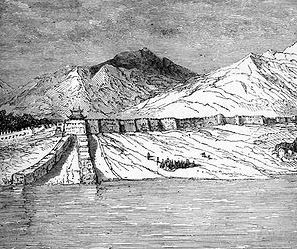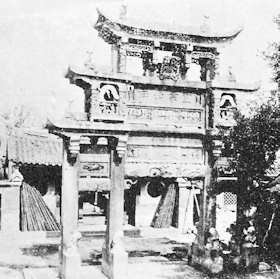
Page created: 2015-03-10
File last modified:

This page is intended to provide a very brief overview of events in the transition from the Míng 明 to the Qīng 清 dynasties. Aside from its broader importance for Chinese history, this was a period of special relevance to the history of Taiwan, even though most of the story told here was played out on the mainland. For a more detailed chronology of Taiwan itself, less detailed than this page for the mainland developments, click here.
The sources are countless reference books, the most useful of which are listed at the end.
Click here for geeky note about English usage.
Lóngqìng 隆庆 / 隆慶 = a dead emperor (reign name)
Wànlì 万历 / 萬曆 = his son and successor (reign name)
Nurhaci (Nǔ’ěrhāchì 努尔哈赤 / 努爾哈赤) = a Jurchen leader (khan)

Tàichāng 泰昌 = an emperor (reign name), son of the Wànlì emperor
Concubine Wáng 王 = his mother.
Concubine Zhèng 郑 / 鄭 = her rival, possibly the murderer of the Tàichāng emperor.
Tiānqǐ 天启 / 天啟 = an emperor (reign name), Sixteen-year-old successor and younger brother of the Tàichāng emperor; a bit dim.
Wèi Zhōngxián 魏忠贤 / 魏忠賢 = his influential tutor, a fabulously corrupt eunuch
Nurhaci (Nǔ’ěrhāchì 努尔哈赤 / 努爾哈赤) = a Jurchen leader (khan)
General Yuán Chónghuàn 袁崇焕 / 袁崇煥 = a loyal and effective but brutal general
Wèi Zhōngxián 魏忠贤 / 魏忠賢 = an influential and fabulously corrupt eunuch
Nurhaci (Nǔ’ěrhāchì 努尔哈赤 / 努爾哈赤) = a Jurchen leader (khan), now dead
Huáng Tàijí 皇太极 / 皇太極 (Abahai in Manchu) = his eighth son and successor (after some contention)
Wèi Zhōngxián 魏忠贤 / 魏忠賢 = a fabulously corrupt eunuch, the real ruler of China until he is forced to commit suicide
Tiānqǐ 天启 / 天啟 = a very weak emperor (reign name)
Chóngzhēn 崇祯 / 崇禎 = his brother and successor, also a weak emperor (reign name)
General Yuán Chónghuàn 袁崇焕 / 袁崇煥 = a loyal and effective but brutal general
Huáng Tàijí 皇太极 / 皇太極 (Abahai in Manchu) = a Jurchen khan who decides they should be called Manchu instead of Jurchens and he should be called an emperor instead of a khan
Chóngzhēn 崇祯 / 崇禎 = a weak emperor (reign name)
General Wú Sānguì 吴三桂 / 吳三桂 = a general charged with holding the pass where the Great Wall meets the sea
Lǐ Zìchéng 李自成 = a frighteningly talented rebel leader
General Dorgon (Duō’ěrgǔn 多尔衮 / 多爾袞) = a Manchu general

Lǐ Zìchéng 李自成 = a frighteningly talented rebel leader
Chóngzhēn 崇祯 / 崇禎 = a weak emperor, unkind to harem women (reign name)
General Wú Sānguì 吴三桂 / 吳三桂 = a general charged with holding the pass where the Great Wall meets the sea; as chaos descends he decided to open the pass.
Lǐ Zìchéng 李自成 = a frighteningly talented rebel leader, inclined to bloodthirstiness
General Dorgon (Duō’ěrgǔn 多尔衮 / 多爾袞) = a Manchu general
Shùnzhì 顺治 / 順治 = the first Manchu emperor (reign name), a Manchu child khan placed on the throne by General Dorgon
Prince Fú 福王 = a grandson of the Wànlì emperor and pretender to the lost Míng throne, reigning at Nánjīng 南京 1644-1645 using the reign name Hóngguāng 弘光; executed in 1646. Sometimes translated Prince of Fú.
Zhèng Zhīlóng 郑芝龙 / 鄭芝龍 = Fújìan province warlord, a Míng loyalist (until he is not)
Prince Guì 桂王 = brother and successor-pretender of Prince Fú, with the reign name Lóngwǔ 隆武.
Zhèng Zhīlóng 郑芝龙 / 鄭芝龍 = Fújìan province warlord, a Míng loyalist (until he is not)
Zhèng Sēn 郑森 / 鄭森 = his impressive son, later known as Zhèng Chénggōng 郑成功 / 鄭成功
Prince Fú 福王 = a grandson of the Wànlì emperor and pretender to the lost Míng throne, reigning at Nánjīng 南京 1644-1645 using the reign name Hóngguāng 弘光; executed in 1646.
Prince Táng 唐王 = competitor to Prince Fú, the Hóngguāng emperor, as the pretender to the Míng throne; reigned in south coastal China from late July of 1644 to September of 1646 with the reign name Lóngwǔ 隆武.)
Prince Guì 桂王 = grandson of Wànlì emperor (from Scene 1) and successor to Prince Táng; reigned Nov 1646 to June 1662 under the reign name Yǒnglì 永历 / 永曆. (Constantly on the run, he will eventually be captured in Burma and strangled in 1662. That is 18 years later. He was good at running.)
Guō Huáiyī 郭怀一 / 郭懷一 = an anti-Dutch rebel leader in Taiwan
Zhèng Chénggōng 郑成功 / 鄭成功 = Míng loyalist general increasingly centered in Táiwān 台湾 / 臺灣 (the former Zhèng Sēn 郑森 / 鄭森)
Zhāng Huángyán 张煌言 / 張煌言 = Míng loyalist warlord in the lower Yangtze region
Shùnzhì 顺治 / 順治 = the first Manchu emperor (reign name), dead of smallpox at age 23
Kāngxī 康熙 = his successor, age 7 (reign name)
Oboi (Áobài 鳌拜 / 鼇拜) = villainous regent for the young Kāngxī emperor
Oboi (Áobài 鳌拜 / 鼇拜) = villainous regent for the young Kāngxī emperor
Zhèng Chénggōng 郑成功 / 鄭成功 = Ruler of Táiwān, still claiming to loyalty to the fallen Míng dynasty
Zhèng Jīng 郑经 / 鄭經 = his son and successor
Zhèng Kèshuǎng 郑克塽 / 鄭克塽 = grandson of Zhèng Chénggōng
General Shī Láng >施琅 = a competent general but not a good diplomatic adviser

This page expands on events in Chinese history relevant to the history of Taiwan. For a more detailed chronology of Taiwan, but with less detail than this page for the mainland developments, click here.
- ÁNG Mànzhēn 唐慢珍 & WÁNG Yǔ 王宇 (eds.)
- 1990 台湾事典. (The book of Taiwan). Tiānjīn: 南开大学出版社.
- CHÉNG Guāngyù 程光裕 & XÚ Shèngmó 徐聖謨 (eds)
- 1984 中國歷史地圖. (Atlas of Chinese history.) Vol. 2. Taipei: 中國文化大學出版社.
- DILLON, Michael (ed.)
- 1998 China: a cultural and historical dictionary. Richmond (Surrey): Curzon.
- GILES, Herbert A.
- 1898 A Chinese biographical dictionary. Leiden: E.J. Brill.
- HUMMEL, Arthur W. (ed.)
- 1943 Eminent Chinese of the Ch’ing period (1644-1912). Washington: U. S. Government Printing Office.
- WINTLE, Justin
- 2002 The Rough Guide history of China. London: Rough Guides.
- PHILLIPS, E. C.
- 1882 Peeps into China: or the missionary’s children. London: Cassell. (Great wall, p. 25.)
- PITCHER, Philip Wilson
- 1912 In and about Amoy: some historical and other facts connected with one of the first open ports of China. Shanghai: The Methodist Publishing House in China. (Koxinga memorial arch, p. 248.)